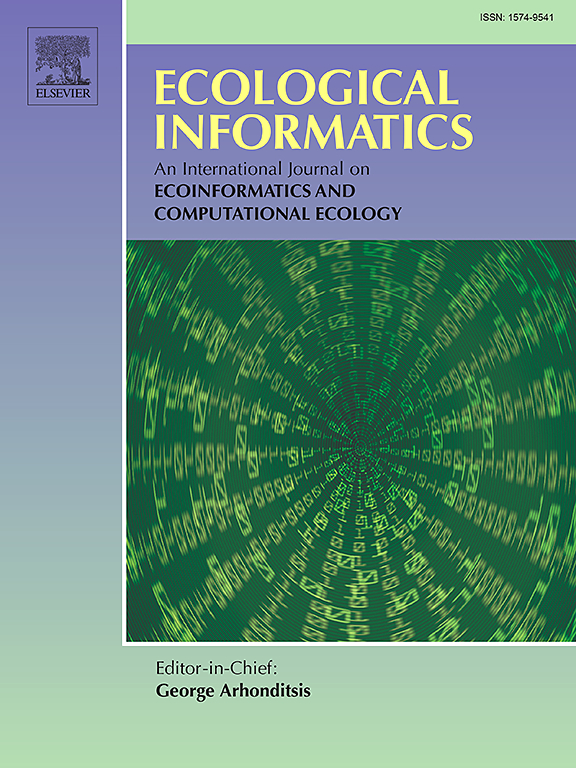将来自无人机和Sentinel-2的数据与prosail - 5d驱动的机器学习相结合,用于农业生态系统中燃料含水量的估算
IF 7.3
2区 环境科学与生态学
Q1 ECOLOGY
引用次数: 0
摘要
燃料含水率(FMC)是评价植被水分状况和生态系统恢复力的重要生态指标,特别是在农业生态系统中。本研究提出了一个集成多源遥感数据融合、基于物理的建模和机器学习的先进框架,以实现高分辨率和高精度的FMC估计。采用加性小波变换(AWT)将无人机(UAV)多光谱图像与Sentinel-2数据融合,生成增强的空间光谱反射率复合材料,同时保留水分分析所需的关键短波红外波段。为了解决稀疏地面观测的挑战,使用校准的PROSAIL-5D辐射传输模型来模拟不同的光谱响应,从而增强训练数据集。利用遗传算法优化的反向传播神经网络,对融合遥感数据和PROSAIL-5D仿真提高FMC检索精度的有效性进行了评估。结果表明:(1)AWT融合方法有效地整合了无人机和Sentinel-2数据,提高了与现场测量的空间和光谱一致性。(2) PROSAIL-5D模型的定标显著提高了等效水厚(Cw, R2 = 0.847)和干物质含量(Cm, R2 = 0.735)这两个FMC计算关键参数的反演精度。(3)将70%的实测光谱数据(无人机和融合后的Sentinel-2)纳入prosaill - 5d模拟数据集,提高了FMC估计精度(R2 = 0.765),比单独使用无人机数据提高了133.94%。该研究展示了数据融合和基于物理的建模在加强农业生态系统植被湿度监测方面的潜力。该方法通过为基于遥感的生态系统水状况分析提供可扩展、可转移的解决方案,为生态信息学做出了贡献。本文章由计算机程序翻译,如有差异,请以英文原文为准。
Integrating data from unmanned aerial vehicles and Sentinel-2 with PROSAIL-5D-driven machine learning for fuel moisture content estimation in agroecosystems
Fuel moisture content (FMC) is a critical ecological indicator for evaluating vegetation water status and ecosystem resilience, particularly in agricultural ecosystems. This study presents an advanced framework integrating multi-source remote sensing data fusion, physically based modeling, and machine learning to enable high-resolution and high-precision FMC estimation. An additive wavelet transform (AWT) was employed to fuse unmanned aerial vehicle (UAV) multispectral imagery with Sentinel-2 data, generating enhanced spatial-spectral reflectance composites while retaining key shortwave infrared bands essential for moisture analysis. To address the challenge of sparse ground observations, a calibrated PROSAIL-5D radiative transfer model was used to simulate diverse spectral responses, augmenting the training dataset. A genetic algorithm-optimized backpropagation neural network was then applied to assess the effectiveness of the fused remote sensing data and PROSAIL-5D simulation in improving FMC retrieval accuracy. The results indicate: (1) The AWT fusion method effectively integrates UAV and Sentinel-2 data, improving spatial and spectral consistency with field measurements. (2) Calibration of the PROSAIL-5D model significantly improves the retrieval accuracy of equivalent water thickness (Cw, R2 = 0.847) and dry matter content (Cm, R2 = 0.735), both key parameters for FMC calculation. (3) Incorporating 70 % of the measured spectral data (UAV and fused Sentinel-2) into the PROSAIL-5D simulated dataset enhanced FMC estimation accuracy (R2 = 0.765), representing a 133.94 % improvement compared with using UAV data alone. This study demonstrates the potential of data fusion and physically based modeling for enhancing vegetation moisture monitoring in agroecosystems. This approach contributes to ecological informatics by offering a scalable, transferable solution for remote sensing-based analysis of ecosystem water status.
求助全文
通过发布文献求助,成功后即可免费获取论文全文。
去求助
来源期刊

Ecological Informatics
环境科学-生态学
CiteScore
8.30
自引率
11.80%
发文量
346
审稿时长
46 days
期刊介绍:
The journal Ecological Informatics is devoted to the publication of high quality, peer-reviewed articles on all aspects of computational ecology, data science and biogeography. The scope of the journal takes into account the data-intensive nature of ecology, the growing capacity of information technology to access, harness and leverage complex data as well as the critical need for informing sustainable management in view of global environmental and climate change.
The nature of the journal is interdisciplinary at the crossover between ecology and informatics. It focuses on novel concepts and techniques for image- and genome-based monitoring and interpretation, sensor- and multimedia-based data acquisition, internet-based data archiving and sharing, data assimilation, modelling and prediction of ecological data.
 求助内容:
求助内容: 应助结果提醒方式:
应助结果提醒方式:


